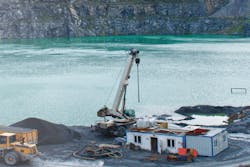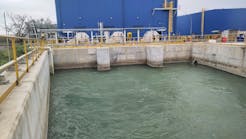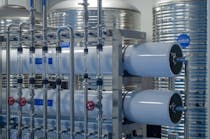The management of mining water is a critical environmental concern. Mining is an essential function because of all the valuable products it produces, including precious metals and gems, bulk minerals like bauxite and limestone, important refineable metal products, and coal. However, if not well managed, mining operations have historically demonstrated a high potential to cause adverse environmental impacts because they reverse the geological processes that, over time, usually stabilized the environments in which the minerals are located.
Water is a factor in many mining and separation processes, so mining water management, use and release are key parts of reducing negative environmental impacts. This column identifies citations where information can be accessed on processes and the regulatory controls that are covered in “Effluent Guidelines for Mineral Mining, Ore Mining and Coal.” The U.S. Environmental Protection Agency (EPA) National Pollutant Discharge Elimination System (NPDES) permits are required for these operations. Its websites represent a huge body of information that is essential for compliance with NPDES permits and requirements in the specific subcategories.
Mineral mining
Effluent Guidelines for Mineral Mining and Processing are contained in 40 CFR Part 436 in the Code of Federal Regulations. The original guidelines were promulgated in 1975, and they have been amended several times in 1976, 1977, 1978 and 1979. The guidelines document currently has 17 inactive and 21 active subcategories (see “Active subcategories”). Technologies are available for each subcategory. However, numerous generic methods are available for water management and treatment. Numerous explanatory supporting development documents were provided with the rulemakings (for example, in the 1979 final rule 44 FR 46793) and later, to assist in implementing the requirements.
Active subcategories
- Subpart B – Crushed stone
- Subpart C – Construction sand and gravel
- Subpart D – Industrial sand
- Subpart E – Gypsum
- Subpart F – Asphaltic mineral
- Subpart G – Asbestos and wollastonite
- Subpart J – Barite
- Subpart K – Fluorspar
- Subpart L – Salines from brine lakes
- Subpart M – Borax
- Subpart N – Potash
- Subpart O – Sodium sulfate
- Subpart R – Phosphate rock
- Subpart S – Frasch sulfur
- Subpart V – Bentonite
- Subpart W – Magnesite
- Subpart X – Diatomite
- Subpart Y – Jade
- Subpart Z – Novaculite
- Subpart AF – Tripoli
- Subpart AL – Graphite
Ore mining & dressing effluent guidelines
Ore mining consists of extracting ores from underground and surface mines. The effluent guidelines are contained in 40 CFR Part 440 that was initiated in 1975 and amended in 1978, 1979, 1982 and 1988. According to the EPA, the processes include mechanical methods, explosives and chemicals. The extraction processes include dressing, picking, sorting and washing; milling, crushing and grinding; and beneficiation, improving the purity and improving the quality of the ores. Wastewater is produced during virtually all these processes, as well as from stormwater runoff from surfaces exposed by mining.
The 12 ore subcategories are iron; aluminum; uranium, radium and vanadium ores; mercury; titanium; tungsten; nickel; vanadium ore mined alone rather than as a byproduct; antimony; copper, lead, zinc, gold, silver and molybdenum; platinum; and gold placer mining.
The EPA published the 2011 “Ore Mining and Dressing Preliminary Study Report” (EPA-820-R-10-025) that collected information on the impacts of operating mining facilities in this category.1 It found that only 2 percent of 294 ore mining facilities with NPDES permits in 2007 were responsible for 90 percent of the toxic weighted discharges and concluded that enforcement and permitting would be more reasonable to pursue rather than revisions of the 40 CFR Part 440 regulations. Total maximum daily load reports were used as indicators of stormwater runoff contributions from active mines and as an indicator of the extent of their contributions to water quality impairment, and again, they did not identify many significant concerns.
Coal mining
The “Coal Mining Effluent Guidelines and Standards” that are contained in 40 CFR Part 434 were published in 1975 and amended in 1976, 1977, 1979, 1982, 1985 and 2002. They include wastewater discharges from mine drainage, coal storage facilities and coal preparation plants. Coal is mined from underground and surface deposits using explosives and mechanical fracturing, and it is processed for washing and crushed for sizing, shipped and stored. Wastewater is generated from the groundwater produced during extraction and from cooling water and dust control processes. Wastewater is also produced during the preparation process, and from stormwater at storage facilities.2 Six subcategories of the facilities are covered in the “Coal Mining Effluent Guidelines and Standards” – including coal preparation plants and associated areas, acid or ferruginous mine drainage, alkaline mine drainage, post-mining areas, coal remining and western alkaline coal mining. Coal remining and western alkaline coal mining were added in the 2002.
The 2002 amendments described the process, pollutants, control and treatment technologies and costs for western alkaline coal mining subcategory. They also provided a guidance manual on best management practices that have been implemented at remining operations. Additionally, they featured substantial information on methods for predicting and preventing acid mine drainage.
When the EPA considered possible revisions to the “Coal Mining Effluent Guidelines and Standards,” it conducted the “Coal Mining Detailed Study” in 2008 to review the status of wastewater discharges from mines, mine drainage characteristics, treatment technologies and costs.3 This study covered information from numerous databases and detailed industry profiles, the existing regulatory framework, coal mine drainage characteristics, acid mine water treatment technologies, treatment studies and costs, pollutant loadings, and environmental impacts. The latter include manganese, mercury, selenium, cadmium and total dissolved solids.
The report provides a wealth of information, technologies, impacts and costs. Particular study emphasis was provided for acid mine drainage and manganese removal, which is a potentially costly requirement. It found only limited information on documented environmental impacts.
The report concluded that, based on the review of the available data, the EPA did not plan to produce revisions to the pollutant limitations in the coal mining effluent guidelines.
Conclusion
The effluent guidelines in the different mining industries are among the oldest regulatory requirements that the EPA has produced, dating back to 1975, with several amendments. Their categories and many subcategories reflect a massive body of detailed information in each subcategory that would need to be digested to obtain a clear understanding of all the environmental impacts, technologies, regulatory requirements, and cost information that have accumulated to manage mining water.
These industry segments in the U.S. are generally not growing, partly because of some depletions, market conditions and economics, and the impacts of the existing regulatory controls. Perhaps highly regulated hydraulic fracturing is one of the few somewhat related extraction processes that continues to grow, although it has been recently depressed because of fuel price declines and some state decisions to add significant restrictions. This slowdown is likely to have been partly fed by the most recent EPA report on the topic with its ambiguous conclusions.4 It found few indications of adverse consequences but has probably been misinterpreted by the press, politicians and anti-fossil fuel advocates.
The 2008 report on coal mining and the 2011 report on ore mining did not uncover significant problems that were not already being adequately addressed by existing effluent guidelines and NPDES permitting processes for mining water. Therefore, additional regulations were not recommended. Studies will continue and technologies will be improved, so further amendments may be made to ensure adequate mining water management.
Resources
- Coal Mining Effluent Guidelines and Standards, 2011
- Coal Mining Effluent Guidelines
- Coal Mining Detailed Study, 2008
- Hydraulic Fracturing for Oil and Gas: Impacts from the Hydraulic Fracturing Water Cycle on Drinking Water Resources in the United States
Joseph Cotruvo, Ph.D., BCES, is president of Joseph Cotruvo and Associates LLC, water, environment and public health consultants, and technical editor of Water Technology. He is a former director of both the EPA Drinking Water Standards and the Risk Assessment Divisions.


